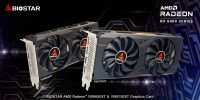(Auszug aus der Pressemitteilung)
SUNNYVALE, Calif. — March 19, 2012 – AMD (NYSE: AMD) today reached a major milestone in the graphics industry with worldwide availability of its full line of next generation AMD Radeon™ HD 7000 Series GPUs in less than three months. Starting in December, AMD launched the AMD Radeon™ HD 7900 Series, followed in February by the AMD Radeon™ HD 7700 Series and completed today with availability of the AMD Radeon™ HD 7800 Series graphics cards.
“Bringing the first 28nm graphics cards to market in December spurred us to continue pushing the boundaries, product after product, culminating with today’s product availability,” said Zvika Greenstein, director of product management, GPU Division, AMD. “Look at our feature set: Graphics Core Next, AMD Eyefinity 2.0, AMD PowerTune, AMD ZeroCore Power technologies and of course our GHz Edition graphics cards – it is without doubt that AMD stands alone in the graphics industry.” 1,2,3
The AMD Radeon™ HD 7970, the world’s fastest and most advanced single GPU,4 unleashed AMD’s revolutionary Graphics Core Next (GCN) architecture and packed in support for PCI Express® 3.0.1, 5 The momentum continued in January with the arrival of the AMD Radeon™ HD 7950 GPU and in February, with the AMD Radeon HD 7700 Series, including the first graphics card to ever break the 1 GHz barrier, the AMD Radeon™ HD 7770.6 With today’s availability of the AMD Radeon HD 7800 Series, packed with 2GB of GDDR5 memory for serious gaming, AMD is leading the way–unrivaled in providing customers with a full lineup of next-generation graphics cards.
Since the launch cycle began, AMD has received over 200 of the industry’s most coveted product review awards and praise from some of industry’s leading reviewers. Currently over 60 SKUs of the AMD Radeon HD 7000 Series product line featuring custom cooling solutions and overclocked engines are available to customers worldwide.7
1 The GCN Architecture and its associated features (PCI Express® 3.0, AMD ZeroCore Power technology, DDM Audio, and 28nm production) are exclusive to the AMD Radeon™ HD 7900, HD 7700 and HD 7800 Series Graphics.
2 AMD Eyefinity technology works with games that support non-standard aspect ratios, which is required for panning across multiple displays. To enable more than two displays, additional panels with native DisplayPort™ connectors, and/or DisplayPort™ compliant active adapters to convert your monitor’s native input to your cards DisplayPort™ or Mini-DisplayPort™ connector(s), are required. Support for five simultaneous displays may require complementary products compatible with DisplayPort 1.2 Multi-Stream Transport. Maximum number of configured displays may vary – check with your component or system manufacturer for specific model capabilities and supported technologies. SLS (“Single Large Surface”) functionality requires an identical display resolution on all configured displays.
3 AMD PowerPlay™, AMD PowerTune and AMD ZeroCore Power are technologies offered by certain AMD Radeon™ products, which are designed to intelligently manage GPU power consumption in response to certain GPU load conditions. Not all products feature all technologies – check with your component or system manufacturer for specific model capabilities.
4 As of December 22, 2011, the AMD Radeon™ HD 7970 scores in excess of X2700 in 3DMark® 11, the highest single-GPU graphics card score achieved on a stock platform to date.
5 Utilization of PCI Express 3.0 bandwidth requires a mainboard equipped with a PCI Express 3.0 PHY. Not all mainboards feature this technology – check with your component or system manufacturer for specific model capabilities.
6 1GHz GPU frequency based on the reference AMD Radeon™ HD 7770 design. GPU frequency may vary for third-party products—check with your component or system manufacturer for complete specifications.
7 AMD’s product warranty does not cover damages caused by overclocking, even when overclocking is enabled via AMD software.




Neueste Kommentare
19. April 2024
17. April 2024
17. April 2024
5. April 2024
23. März 2024
22. März 2024